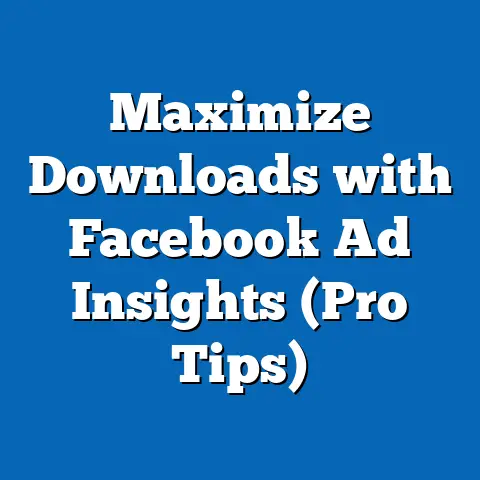Master Facebook Ad Spend Limits (Unlock Hidden Potential)
In the realm of digital marketing, comfort is a critical yet often overlooked factor in crafting successful advertising campaigns. Comfort, in this context, refers to the psychological and emotional ease with which individuals engage with technology, platforms, and advertisements tailored to their preferences and experiences. For different generations, comfort levels with digital tools like Facebook vary widely, influenced by historical context, technological exposure, and societal norms.
Understanding generational comfort is essential for marketers aiming to optimize their Facebook ad spend limits—a mechanism designed to control advertising budgets while maximizing reach and impact. This article delves into the concept of generational comfort, explores its defining characteristics, and examines the historical and societal factors that shape it. By integrating this understanding with a strategic approach to mastering Facebook ad spend limits, businesses can unlock hidden potential in their campaigns, ensuring they resonate with diverse audiences.
Section 1: Defining Generational Comfort in the Digital Age
Generational comfort with digital platforms like Facebook is shaped by a combination of familiarity, accessibility, and cultural alignment. For instance, younger generations such as Gen Z (born 1997–2012) often exhibit high comfort levels with social media due to their upbringing in a hyper-connected world. In contrast, older generations like Baby Boomers (born 1946–1964) may approach these platforms with caution, influenced by less exposure to technology during formative years.
Comfort is not merely about technical proficiency; it also encompasses trust in digital environments, receptivity to targeted ads, and alignment with platform-specific content styles. A 2021 Pew Research Center study found that 70% of Gen Z and Millennials (born 1981–1996) feel comfortable sharing personal data for personalized ads, compared to only 40% of Baby Boomers. This disparity highlights how comfort influences engagement with advertising strategies.
Societal implications of generational comfort are profound, affecting how brands allocate budgets and tailor messaging. Marketers who overlook these differences risk alienating segments of their audience, wasting ad spend on ineffective campaigns. Understanding comfort, therefore, serves as a foundation for optimizing tools like Facebook ad spend limits, which allow for granular control over budget distribution across demographics.
Section 2: Historical Context Shaping Generational Comfort
To fully grasp generational comfort, it’s essential to consider the historical events and technological milestones that have shaped each cohort. Baby Boomers, for example, grew up during post-World War II prosperity, a time when traditional media like television and radio dominated communication. Their limited early exposure to digital technology often translates to lower comfort with platforms like Facebook, though many have adapted in recent years for social connection.
Generation X (born 1965–1980) witnessed the rise of personal computing and the early internet, positioning them as a bridge between analog and digital worlds. This group often displays moderate comfort with social media, valuing functionality over immersion. Significant events like the dot-com boom shaped their pragmatic approach to technology.
Millennials, on the other hand, came of age during the internet’s mainstream adoption and the launch of social media platforms like Facebook in 2004. Their high comfort with digital tools stems from formative experiences with MySpace, early smartphones, and instant messaging. Meanwhile, Gen Z, born into a world of ubiquitous connectivity, views platforms like Facebook as secondary to newer apps like TikTok, yet still engages with it for specific purposes like event planning or marketplace transactions.
These historical contexts reveal why comfort levels differ and underscore the need for tailored ad strategies. Facebook ad spend limits, when adjusted to reflect these generational nuances, can prevent overspending on less receptive audiences while maximizing returns on engaged demographics.
Section 3: Societal Implications of Generational Comfort in Marketing
The varying levels of comfort across generations have far-reaching implications for society and digital marketing ecosystems. For one, they influence how trust is built between consumers and brands in online spaces. Younger generations, accustomed to data sharing, may respond positively to hyper-personalized ads, while older generations might perceive such tactics as invasive, impacting brand loyalty.
Economically, generational comfort affects how advertising budgets are allocated. A 2022 eMarketer report indicated that brands spend nearly 60% of their social media budgets on platforms targeting Millennials and Gen Z, often underfunding campaigns for older demographics. This imbalance can perpetuate digital exclusion, limiting access to information or products for less tech-savvy groups.
Culturally, comfort shapes the tone, style, and content of advertisements. For instance, humor-driven, meme-based ads may resonate with Gen Z but fall flat with Baby Boomers, who might prefer straightforward, value-driven messaging. Marketers must navigate these cultural nuances to ensure campaigns are inclusive, a task made easier by leveraging tools like Facebook ad spend limits to test and refine approaches across audience segments.
Section 4: Mastering Facebook Ad Spend Limits: A Strategic Overview
Facebook ad spend limits are a powerful feature within Meta’s advertising platform, allowing marketers to cap daily or lifetime budgets for campaigns, ad sets, or individual ads. This control mechanism is particularly valuable when targeting diverse generational audiences with varying comfort levels. By setting precise limits, businesses can allocate resources efficiently, avoiding overspending on underperforming demographics while scaling successful campaigns.
The process begins with defining clear objectives—whether brand awareness, lead generation, or conversions—and segmenting audiences by generational characteristics. For instance, a campaign targeting Gen Z might prioritize video content on Facebook Stories with a modest daily spend limit to test engagement. Conversely, a campaign for Baby Boomers could focus on static carousel ads promoting trust and reliability, with a slightly higher limit to account for lower initial engagement rates.
Data-driven experimentation is key to mastering spend limits. Facebook’s analytics tools provide insights into cost-per-click (CPC), click-through rates (CTR), and return on ad spend (ROAS), enabling marketers to adjust limits based on real-time performance. A 2023 study by Social Media Today found that campaigns with dynamic spend limits—adjusted weekly based on performance—achieved 25% higher ROAS compared to static budgets.
Section 5: Generational Nuances in Facebook Ad Spend Strategies
Applying spend limits effectively requires a deep understanding of generational preferences and comfort levels. Let’s explore tailored strategies for key cohorts, acknowledging the diversity within each group and avoiding overgeneralization.
Baby Boomers (1946–1964):
This generation often values clarity and trustworthiness in ads. Spend limits for Boomer-targeted campaigns should prioritize quality over quantity, focusing on a smaller, highly engaged audience. For example, a lifetime spend limit of $500 for a week-long campaign promoting financial services can test messaging around security and legacy planning. Engagement may be lower, but conversion rates for high-value products are often significant, as noted in a 2021 Nielsen report showing Boomers account for 50% of consumer spending in key sectors.
Generation X (1965–1980):
Gen Xers, balancing digital familiarity with skepticism, respond well to value-driven content. A daily spend limit of $50–$100 per ad set can support campaigns highlighting product utility or nostalgia, with formats like video testimonials performing strongly. Their moderate comfort with Facebook means split-testing multiple ad creatives within a constrained budget can uncover effective approaches without excessive expenditure.
Millennials (1981–1996):
Millennials, highly comfortable with social media, are a prime target for dynamic spend limits. Marketers can start with a low daily cap of $20–$30 per ad set, scaling up to $200+ as engagement metrics improve. Campaigns focusing on authenticity, social impact, and interactive content (e.g., polls or live events) often yield high CTRs. A 2022 HubSpot survey found 65% of Millennials engage with brands on social media weekly, justifying flexible spend limits.
Generation Z (1997–2012):
Gen Z’s comfort with digital platforms is unparalleled, though their attention spans are short, and loyalty to Facebook is lower compared to platforms like Instagram or TikTok. Spend limits for this group should be conservative initially—around $10–$20 daily per ad set—focusing on visually striking, trend-driven content. Rapid iteration based on performance data is crucial, as Gen Z’s preferences shift quickly. eMarketer data from 2023 indicates Gen Z accounts for 20% of social media ad engagement despite being a smaller demographic, highlighting their outsized influence.
Section 6: Technological and Economic Factors in Ad Spend Optimization
Technological advancements within Meta’s advertising ecosystem play a significant role in leveraging spend limits effectively across generations. Features like automated bidding and machine learning algorithms can optimize ad delivery within set budgets, ensuring ads reach the most receptive users. For instance, Facebook’s Advantage+ campaigns automatically adjust spend distribution based on performance, a boon for marketers targeting tech-savvy Millennials and Gen Z.
Economically, the cost of advertising on Facebook varies by demographic due to competition and engagement levels. CPC for Gen Z and Millennial audiences often ranges from $0.50 to $1.00, reflecting high demand, while costs for Baby Boomers can be lower at $0.30–$0.70 due to less crowded ad space. Spend limits must account for these disparities to avoid budget depletion on high-cost segments without proportional returns.
Additionally, economic conditions influence generational purchasing power, affecting ad outcomes. During economic downturns, Gen X and Baby Boomers may prioritize essential spending, necessitating tighter spend limits and value-focused messaging. Conversely, younger generations might remain open to discretionary purchases if ads align with their values, as seen in a 2023 Deloitte study on Gen Z’s preference for sustainable brands.
Section 7: Social and Cultural Influences on Campaign Effectiveness
Social norms and cultural trends further complicate the application of spend limits across generations. For Baby Boomers, ads emphasizing community, family, or tradition often resonate, requiring a steady, predictable spend limit to build trust over time. Cultural shifts, such as the growing focus on privacy, also impact older generations’ comfort, with many opting out of personalized ads—a factor marketers must consider when setting budgets.
Millennials and Gen Z, shaped by a culture of individuality and social activism, respond to campaigns addressing diversity, inclusion, and environmental concerns. Spend limits for these groups should allow for experimentation with cause-related marketing, as a 2022 Edelman Trust Barometer report found 60% of younger consumers buy from brands aligned with their values. However, cultural missteps can lead to backlash, necessitating cautious budget allocation until messaging is refined.
Cross-generational campaigns, blending universal themes like nostalgia with modern delivery, can also benefit from tiered spend limits. For example, a campaign evoking shared cultural touchpoints—think retro branding with a modern twist—might allocate 40% of the budget to Millennials, 30% to Gen X, and the remainder split between Boomers and Gen Z, adjusting based on engagement data.
Section 8: Workplace and Societal Implications of Optimized Ad Spend
Mastering Facebook ad spend limits has implications beyond marketing, influencing workplace dynamics and broader societal trends. In the workplace, marketing teams must adapt to intergenerational collaboration, with younger employees often driving digital strategy while older team members offer insights into traditional consumer behavior. Spend limits foster accountability, ensuring budgets align with measurable outcomes, a priority for data-driven Millennials and pragmatic Gen Xers alike.
Societally, optimized ad spend can reduce digital fatigue by preventing oversaturation of ads among less comfortable demographics. It also promotes inclusivity by enabling brands to reach underrepresented groups without excessive costs. For instance, small businesses with limited budgets can use precise spend limits to target niche generational segments, leveling the playing field against larger competitors.
However, there’s a risk of reinforcing generational divides if spend limits disproportionately favor high-engagement groups like Gen Z. Marketers must balance efficiency with equity, ensuring older or less digitally active audiences aren’t sidelined, as their purchasing power remains significant. A 2023 McKinsey report emphasized that Baby Boomers and Gen X control over 70% of global wealth, a reminder of their economic influence despite lower digital comfort.
Section 9: Challenges and Nuances in Applying Spend Limits
While spend limits offer control and efficiency, challenges arise in their application across generations. One key issue is the diversity within cohorts—not all Baby Boomers are tech-averse, just as not all Gen Zers are social media natives. Marketers must use detailed audience segmentation, leveraging Facebook’s demographic and interest-based targeting, to account for these nuances rather than relying on broad generational assumptions.
Another challenge is platform algorithm changes, which can disrupt campaign performance and render preset spend limits ineffective. For example, Meta’s 2021 shift to prioritize privacy over ad tracking reduced targeting precision, disproportionately affecting campaigns for older generations with less digital footprint data. Adaptive spend limits, reviewed biweekly, can mitigate such risks.
Qualitative feedback, such as focus group insights, complements quantitative metrics in refining spend strategies. A 2022 Forrester study highlighted that 45% of marketers who integrated user feedback into budget allocation saw improved campaign resonance across age groups. This mixed-methods approach ensures spend limits align with both data and human experience.
Section 10: Forward-Looking Insights and Uncertainties
Looking ahead, mastering Facebook ad spend limits will become increasingly complex as generational dynamics evolve. The rise of Generation Alpha (born 2013–present), fully immersed in digital environments from birth, will introduce new comfort benchmarks, potentially shifting ad spend priorities. Meanwhile, aging populations in many developed countries will necessitate sustained focus on Baby Boomers and Gen X, whose digital adoption continues to grow—albeit at a slower pace.
Technological uncertainties, such as the impact of artificial intelligence on ad personalization or potential regulatory changes around data privacy, could reshape how spend limits are applied. Marketers must remain agile, using tools like Facebook’s split testing and predictive analytics to anticipate shifts in generational behavior.
Ultimately, the hidden potential of spend limits lies in their ability to foster precision and adaptability. By grounding strategies in a nuanced understanding of generational comfort, businesses can craft campaigns that resonate across age groups, balancing immediate returns with long-term brand equity. While the future holds uncertainties, one truth remains: thoughtful, data-informed budgeting will be the cornerstone of digital marketing success.
Conclusion
Mastering Facebook ad spend limits offers a pathway to unlocking hidden potential in generational marketing, provided strategies are rooted in an understanding of comfort, historical context, and societal trends. From Baby Boomers’ cautious engagement to Gen Z’s digital fluency, each cohort presents unique opportunities and challenges that spend limits can address through precision and experimentation. As technology evolves and demographics shift, the ability to adapt budgets dynamically will distinguish successful campaigns from wasted efforts, ensuring brands connect meaningfully with diverse audiences in an ever-changing digital landscape.






